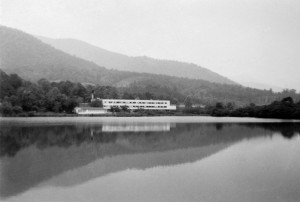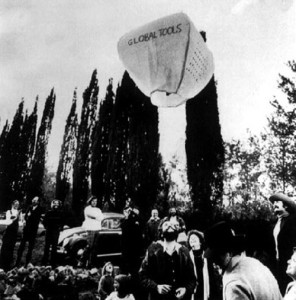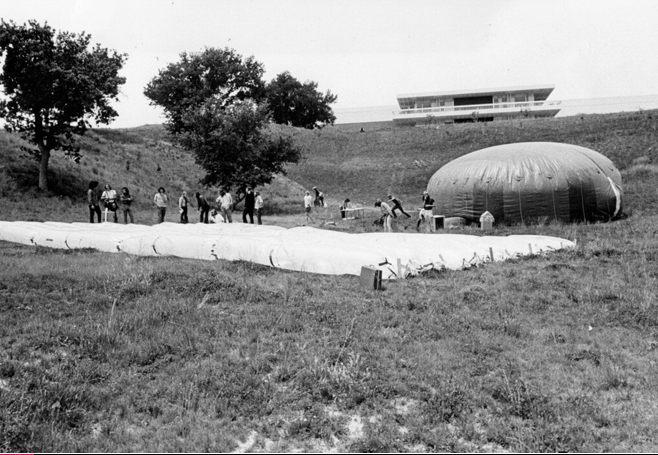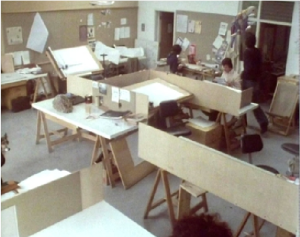- Ê
- Â
å Wednesday, September 25th, 2013
Bauhaus (1919-19132?) Sara
Distinguishing characteristics
Why did it emerge? (What was it a reaction to? What motivated the founding?)
What was the curriculum or model on which the program was based?
- reinvents itself again and again
- marriage of art and technology
Research Resources:
Black Mountain (1933-1957) David
Distinguishing characteristics
- 4-year Undergrad college (liberal arts school, not art school)
- John Dewey’s progressive education model – direct experience over delivered knowledge
- Correlation of body, mind and spirit
- Isolation as productive
- Josef Albers and wife: art as process, not product
- Holistic model of arts
- Focus on community: Dining hall as center, close connection between students and faculty
- Self-governed – attendees in charge of their own education
- Learning and labor
- Focus on experimentation: emphasis on originality
- Summer program intensive
- Not many graduated
Why did it emerge? (What was it a reaction to? What motivated the founding?)
- To establish model of progressive education
- Experiment of “education in a democracy” — first school to have complete democratic self rule
What was the curriculum or model on which the program was based?
- No required classes or set schedule
- Classes were composed of recitations, lectures, tutorials, and seminars
- Teachers free to teach whatever they want
- Students determine whatever they want to study
- Junior division and senior division – moved when ready rather than institional progress. Judged by written and oral examinations
- When ready outside evaluator would determine whether student could graduate
Research Resources:
http://www.blackmountaincollege.org/history
http://www.blackmountainstudiesjournal.org/wp/
http://www.ibiblio.org/bmc/bmcaboutbmc.html
Ulm (1953-1968) Calvin
- Founded by max bill, Bauhaus , Otl Aicher and
- Visual Comm
- Post WW II reconstruction period
- Fed and private funding
- Foundation then specialization
- Moved from formgivng (art) to systems design (science)
- Taught technical, legal…
- Vis Communication taught semiotics
- Partner with Braun (Dieter Rams) “honest form” – integration with industry
- Production-based (systems) thought
Research Resources:
International Design Conference at Aspen (1951) David
Distinguishing characteristics
- Conference established in 1951
- Place to discuss big ideas
- Bring together design and business
- Focus on the “whole man” and renewal of body mind and spirit. Retreat
- Bring people together from different disciplines
- Early topics: Design and Human Values
Why did it emerge? (What was it a reaction to? What motivated the founding?)
- Vision on the part of Walter Paepcke that great ideas would only come from giving design and industry leaders a specific time and place to gather to share ideas
- Need for design to think cross disciplinarily
What was the curriculum or model on which the program was based?
- Many ops to work together with others
- Main conference followed by smaller break-off groups
Research Resources:
http://www.aiga.org/aspen-design-summit/
http://archive.org/details/InternationalDesignConferenceInAspenTheFirstDecade
http://www.aspeninstitute.org
Construction School (1963-65 and 1968-1977) Eline
Distinguishing characteristics
- Norman Potter rewrote way school function
- Interdisc and collaboration From 1964
- 1974-1977 Norman Potter – decentralized structure of school so teacher and students on same level — no hierarchy. Potter leaves in 1977
Potter envisioned the Construction School as a British version of the Bauhaus, which would imbue the students with an idiosyncratic mix of Modernism, the Arts and Crafts movement, anarchism, environmentalism and Christianity.
The Construction School, founded by Norman Potter with a small group of collaborators, was a bold attempt to establish an experimental design school in a provincial English context. The first phase of Potter’s involvement (1964 to 1968) placed an emphasis on interdisciplinary practices and collaboration. The second phase (1975 to 1977) went further, defined by a radical effort to decentralise the educational structure of the school. The school was a product of major changes in the structure of art and design education in the UK. In 1960 a new qualification, the Diploma in Art and Design (DipAD) was introduced, intended to formalise standards in the field. A process of granting accreditation to colleges to offer this new qualification began, with brutal results: only 61 courses were approved to run the DipAD from over 200 applicants. The West of England College of Art lost out in this process, and urgent action was required to found a new course and resubmit for DipAD accreditation. Norman Potter, then teaching at the RCA in London, was approached and given the opportunity to found such a course in Bristol. This difficult inception is typical of much of the school’s story: institutional resistance was a recurrent pressure. The efforts of the school to define itself were constantly foiled, and as early as early as 1966 it was in sufficient trouble to solicit a petition in its defence by a significant list of architects and designers. In 1968 the student sit-in at Hornsey College of Art brought these questions to the attention of the public and prompted extensive discussion on the function of art and design education.
Research Resources:http://www.spikeisland.org.uk/blogs/2012/07/06/on-the-construction-school
CalArts Louise
What is the program?
- School of Design, CalArts
- Established 1970; in late1975 3-D closes and 2-D absorbed into Art School
- Focus on addressing world problems and social issues
- Diverse interests and faculty including psychology, politics, architecture, product design, graphic design. Victor Papanek, Craig Hodgetts, Peter de Bretteville, Sheila de Bretteville
- Explored experimental building practices based in nature; furniture systems, etc.
- 1971 Women’s Design Program established
Why did it emerge? (What was it a reaction to? What motivated the founding?)
Saw next step in evolution of democracy: cultural democracy: Given more leisure time and rapidly expanding new mediums (TV, motion pictures, audio recordings) need seen for arts professionals to produce “serious arts”
What was the curriculum or model on which the program was based?
- Rather than individual studios and academies with each discipline separate, CalArts offers “single inter-disciplinary, cross-fertilizing training ground in full range of the plastic, applied, and performing arts.” Single building to unify. Community of student and teaching artists stimulus and invigoration of “josling together”
- CalTech was model: CalTech concentrated solely on sciences and to train and nourish enlarged vision/CalArts solely on arts as well train and nourish enlarged vision
- Wanted to attract those interested in “experimentation and innovative communications techniques”
- Train and Nourish!: Technique/craftsmanship and nourishing creative spirit rather than apprenticeship
- Against overspecialization
- Upon graduation contribution to innovative art forms and possibly invent new ones.
- Also influenced by Perspecta 11 (publication from Yale) and Blueprint for Counter Education — “a tool for creating a counter education” were the participant will confronted by ideas and issues that compel him to interact with everything going on around him — from movies, to riots, to political campaigns.”
Research Resources:
TC
Cranbrook (1971) Sara
Distinguishing characteristics
- Kathy McCoy started with prof experience better was to communicate cultural activity
- Outside confines of professional practice
- Saw need to evolve and reconsideration of
- Cross disciplinary influences
- Structure to foster creativity
- Desire to make designer more visible
Why did it emerge? (What was it a reaction to? What motivated the founding?)
- Responded to statis — model weren’t working
- Challenged model of universal design
What was the curriculum or model on which the program was based?
Global Tools (1973-1975)
- Functions of Hand and the Mind after exhibition in Italy “The New Domestic Landscape
- Superstudio, Archizoom, Sotssass,
- Started a project with seminars and workshops: 1 seminar and 2 magazine
- Broke off into individual interests
In 1973, a large group of architects, designers and artists gathered “to bridge the alienating gap which has been created between the functions of the hands and those of the mind.”
Known as Global Tools this was the second most important moment for the radicals. It took place one year after Italy: the new domestic landscape, the unifying exhibition which gave rise to the radical’s fame. In attendance at casabella’s headquarters in Milan were Lapo Binazzi and the rest of UFO, Germano Celant, Ugo la Pietra, Alessandro Mendini, Franco Raggi, Ettore Sottsass jr., Archizoom Associati, Remo Buti, Riccardo Dalisi, 9999, Gaetano Pesce, Gianni Pettena, Press, Superstudio and Zzigguratt.
The size of the group was massive and scope of the project was highly focused. The goal was to form a series of seminars and workshops addressing “the study and use of natural techniques and materials” symbolized by rudimentary tools like a hammer. Superstudio began acquiring and documenting the simple tools found in southern Italian towns, eventually concentrating on the walking stick as an artifact.
Unfortunately Global Tool’s vision was too particular and Superstudio was not the only group. It seems impossible to have groups like Archizoom, who embraced the effects of modernization collaborating with Superstudio or Gianni Pettena. Global Tools eventually failed in 1975 after only a single seminar and two magazines. This moment also highlighted the divisions amongst what seemed to be a focused and unified group of radical architects three years prior at INDL.
While groups like Superstudio and Archizoom are often shown in tandem, they seem more like foils. Archizoom chose to explore the new tenants of a modern Italy, whereas Superstudio began to turn to the past.
Resources:http://rolu.terapad.com/?fa=contentNews.newsDetails&from=list&newsID=191441
Bruno Munari Workshops (1980)
Distinguishing characteristics
- Alternative to learning techniques and rote by encouraging experimentation in books
- In conjunction with workshop series with children.
- Sets up scenarios and then
- Did some workshops with adults to put into… “Play with Art”
- Do it yourself by yourself
Why did it emerge? (What was it a reaction to? What motivated the founding?)
What was the curriculum or model on which the program was based?
Research Resources:
3 responses to “EXAMPLES/MODELS: HISTORICAL EXPERIMENTAL (DESIGN) EDUCATION”
Leave a Reply Cancel reply
-
Classroom
Topics and Themes
-
Recent Posts
Recent Comments
- Calvin on REVISE RESEARCH AND CONTEMPLATE NEXT STEPS
- David on REVISE RESEARCH AND CONTEMPLATE NEXT STEPS
- Louise on REVISE RESEARCH AND CONTEMPLATE NEXT STEPS
- Louise on EXAMPLES/MODELS: HISTORICAL EXPERIMENTAL (DESIGN) EDUCATION
- Elliot Vredenburg on EXAMPLES/MODELS: HISTORICAL EXPERIMENTAL (DESIGN) EDUCATION
Archives
Most Tagged!
-
About





Logging in worked now so I’m filling in some of the missing details.
Although I’ve only been present for a portion of one of the classes thus far, I thought I’d quickly post some thoughts on the goals of this course (and design pedagogy in general), as per Louise’s request.
“Possible directions for graduate graphic design education” is a great start, but leaves something to be desired, IMO. I’d propose that a goal for the course could be, in fact, discovering real goals for graphic design education, as a whole.
Throughout my undergrad, there were two streams of focus. One was the vocational side of things: learning how to use CS, hard-and-fast rules about typography, how to bullshit, digital to analogue reproduction, and so forth. Second, there was an emphasis on developing a theoretical framework to situate one’s self in. Thus, I developed a strong framework based between Situationism and post-structuralism, and vast proficiencies in digital and print production. Though, due to the gaping chasm between these two aspects, this led to paralysis after graduating. I had learned how to apply design thinking TO the world, but not IN the world.
What really intrigues me is the opportunity to develop new design pedagogies which synthesize these two approaches. One way I think is effective in engaging both of these aspects is the use of “design fiction,” as demonstrated by Dunne & Raby, Noam Toran, etc. I see this is as an example of how we can learn/teach how to work IN the world, by extending our field beyond immaterial labour and the service-based paradigm we traditionally work within, in order to provoke change from an existing situation into a preferred one (which, I would argue, is a suitable definition of the practice of design). This approach also addresses issues of autonomy and collaboration with other disciplines.
I don’t know if this made any sense, but hopefully this contributes adequately to a critical discourse about the potentialities of design pedagogy. Any response to these musings would be appreciated.
Thanks for the comments, Elliot!
Re: Real goals for graphic design education. Hmmm… Are there? Or are there different configurations of goals depending on the values and of the various and diverse institutions (or entities in which design education takes place). (Also, if we’re looking goals, a distinction has to be made between undergrad and graduate ones.) Nonetheless I get that you’re asking a meta-question. Right on!
So maybe we could say that your proposal is that as a class we could define a goals graphic design education as we see is needed — and then “design” what that Program might look like.
Also, just a heads up that the work we’ve been doing the last few weeks is to look at different models experimental/alternative (graphic) design education — both contemporary models and well his historical ones. Seems like you probably have some ones to add. And, BTW, I’m going to present a recent project of Dunne & Raby’s in class tomorrow or the near future.